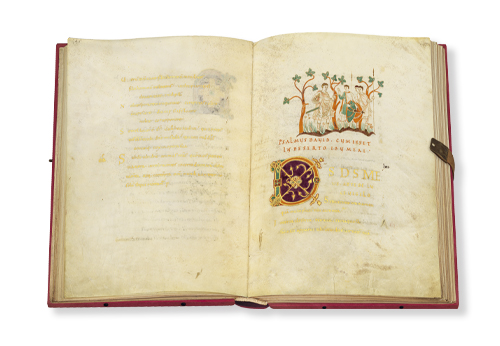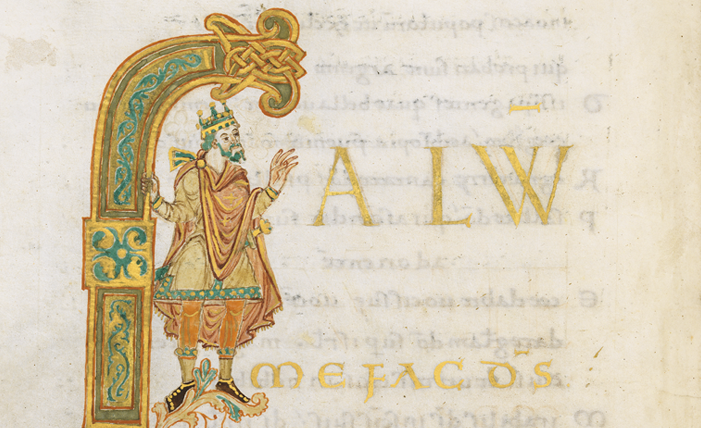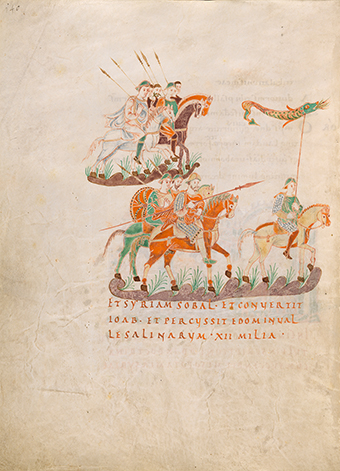
The Golden Psalter of St. Gall
A Radiant Masterpiece of the Carolingian Era
Faksimile-Edition
The “Psalterium aureum” of St. Gall: The Manuscript
Carolingian Minuscule in Gold
The Psalterium aureum of St. Gall presents the Psalms – apart from their titles – in Carolingian minuscule: unconnected, regularly formed lowercase letters. Carolingian minuscule emerged as a very legible script around 800 and spread throughout Europe during the reign of Charlemagne. We now know that this manuscript was initially written using brass ink, which could imitate gold. The text was later completely redrawn with gold by illuminators in St. Gall. The Psalter first become an exemplar of the art of the book in St. Gall around 870/80, when the still-unbound folios arrived at the monastery on the Steinach River, and work began to add the missing texts and images and to revise the original in several places.
Produced in the Circle of Louis the German?
A Gold Treasure of the Abbey Library of St. Gall
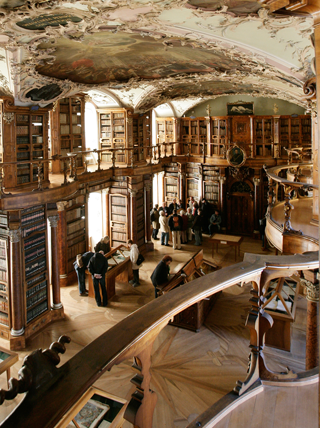
Under the Magnifying Glass: David’s Horsemen in Frankish Clothing
The Golden Psalter of St. Gall: The Edition

The Manuscript and the Facsimile at a Glance
Manuscript: Abbey Library of St. Gall, Cod. Sang. 22
Date of Origin: 870-900
Place of Origin: Francia (Soissons?) and the St. Gall Monastery
Format: 37 x 28 cm
Extent: 344 pages (172 folios)
Artists: West Frankish manuscript illuminators and scribes, St. Gall Scriptorium
Patron: Presumably from the circle of Louis the German, King of East Francia (r. 843 to 876).
Illumination: The gold lettering, the many gold decorative initials, and the 17 expressive miniatures on 344 pages have been faithfully reproduced in the facsimile edition.
Binding: Faithfully to the original, the facsimile is bound in red leather with wooden covers. Because the originally badly damaged by rubbing, the precious pages inside are protected by an undamaged binding. Brass buttons and a brass clasp decorate the binding like the original. The headband is handsewn.
Volume for the Facsimile Edition: Prof. Dr. David Ganz (Universität Zürich), Dr. Thomas Rainer (Universität Zürich) and the team of authors from the Abbey Library of St. Gall – Dr. Ulrike Ganz, Dr. Ursula Kundert and Dr. Philipp Lenz – are specialists for this fascinating art of the Carolingian era. In chapters that make for fascinating reading, the authors introduce us to an illuminated manuscript more than 1,100 years old. The facsimile and commentary volume are protected by a handmade slipcase.
Print Run: 480 copies
Faksimile-Edition
Several Pages for Viewing:
A Glance at the Golden Psalter
The excerpt for perusal chosen from the Golden Psalter of St. Gall comprises pp. 140–152. It reveals from this treasury of Psalms a beautiful interplay of minuscules, initials, and miniatures.
p. 141: Illustration for Ps 59/60. Storming of the city of Edom and pillage by horsemen and foot soldiers; below: presumably, the handing of the city to Joab and his horseman.
p. 147: Illustration for Ps 62. David in desert of Edom (with grass and trees). The people are wearing Frankish clothing.
p. 150: Illustration for Ps 64 and figures of the prophets Jeremiah and Ezekiel, in front of a closed gate in the form of a rectangular frame with an inscribed cross.
p. 151 Initials, lettering in gold, on a square, purple ground.
Faksimile-Edition
A Challenging Production: fac simile
Brass Ink, Gold and Patina
The Golden Psalter was originally executed in brass ink, but the early entries were later painted over with gold by monks in St. Gall. This lent a special character to the gold. More than 1,100 years have also left their traces on the gold. Some places still gleam, while others are rather dull. Sometimes it is yellowish, but it is greenish in some places. The gold lithographer had to work out all these differences and realize them with the patina, which is printed over the gold leaf.
Purple Finery
Writing and pen drawings (in purple, purplish-brown or bright sepia, embellished with minium, green, purplish-brown, blue and gold) supplement each other perfectly in the St. Gall Psalter. Purple, which is still the most expensive pigment today, is the theme of an entire chapter in the commentary volume. The shades of minium also represented a challenge. The tiniest deviations in colour result in a different impression. Special treatment of the paper by hand makes it wavy and matte like parchment.
The Art of Lithographers
The colours of Codex Sangallensis 22 are opaque paints of pigments and fillers. The most delicate corrections are necessary to produce the shades as faithfully to the original as possible. Lithographers compare the pages in situ in the Abbey Library of St. Gall and meticulously note any corrections needed. The sheet for the facsimile folder is printed on the same paper that will be used for the edition.
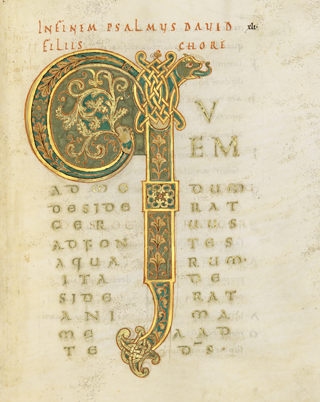
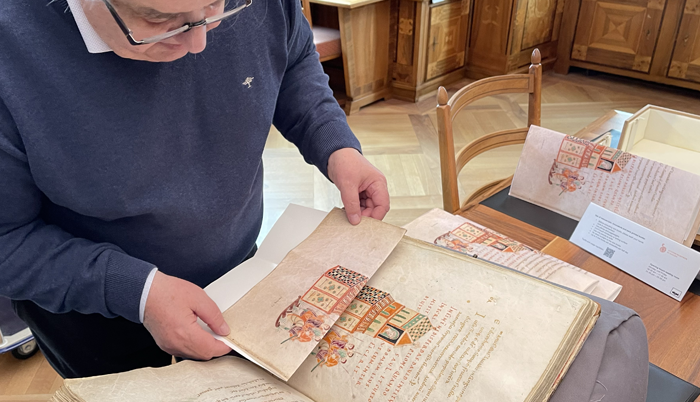
Faksimile-Edition
The Facsimile Folder for the Edition
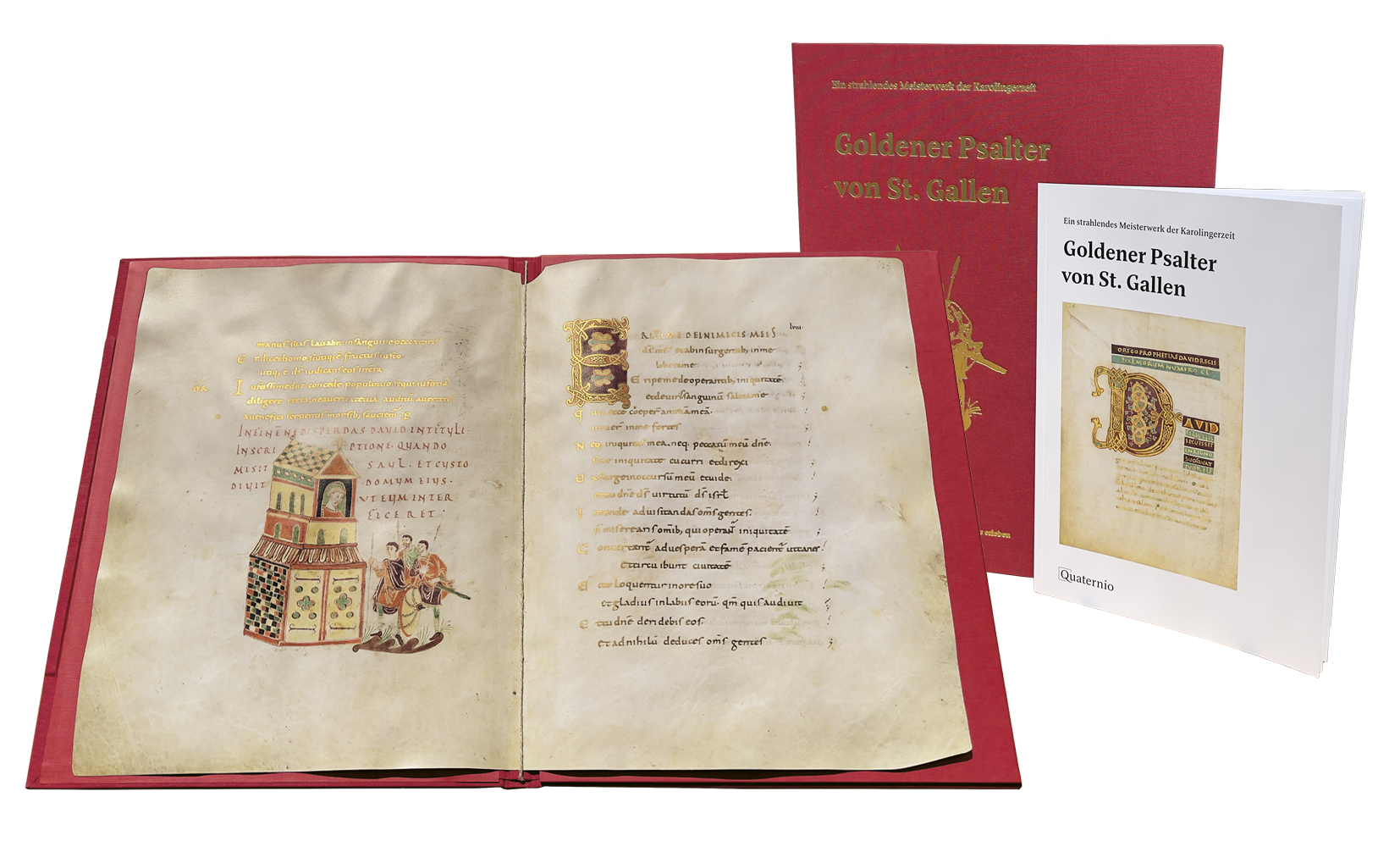
The handmade, clothbound facsimile folder with a format of 39 x 29 cm contains an original facsimile sheet (pp. 135–138), along with an essay by one of the authors of the commentary volume, Prof. Dr. David Ganz. The original facsimile sheet is inserted loose in the folder for easy removal.
Goldener Psalter von St. Gallen




